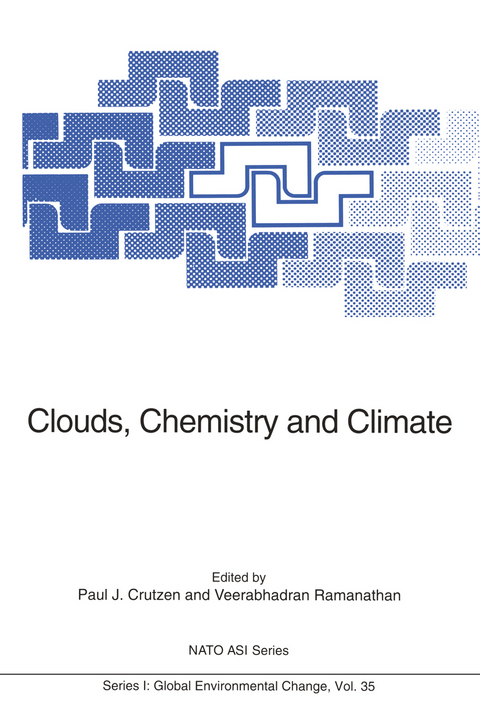
Clouds, Chemistry and Climate
Springer Berlin (Verlag)
978-3-642-64672-0 (ISBN)
The objective of this NATO Advanced Research Workshop was to discuss our current understanding of the role of clouds in climate and chemistry. The range of topics dis cussed during the workshop included: modeling of clouds in GCMs; observations of the cloud micro physical properties; the water vapor cycle; troposphere-stratosphere exchange; role of in-cloud transport in tropospheric ozone; regulation of current and paleo climate by clouds; and anthropogenic sulfate aerosols and modification of cloud properties. The essence of the discussions is captured in the accompanying summary by the rapporteurs and the chapters by some of the speakers. The underlying message is that significant progress has been made, resulting in exciting new developments in our perception of the role of clouds in the global system . .. The tropical convective-cirrus cloud systems emerge as a major influence on the climate system. Micro physical processes, such as the rate of precipitation and re evaporation of ice particles, seem to regulate the large scale vertical distribution of water vapor which is the dominant greenhouse gas. Water vapor data collected during the Central Equatorial Pacific Experiment (CEPEX), document the large moistening effect of deep convection on scales of thousands of kilometers. A major chemical finding in the same region was the observation of extremely low ozone 8 volume mixing ratios of less than 10- in the entire troposphere of the central equatorial Pacific extending over a distance of about 2000 km. This finding establishes the Pacific as a major chemical sink region for tropospheric ozone.
Paul J. Crutzen, geboren 1933 in Amsterdam, leitete von 1980 bis 2000 das Max-Planck-Institut für Chemie in Mainz. 1995 erhielt er den Nobelpreis für Chemie.
1: NATO ARW Session Summaries.- 1. Radiative Convective Interaction in the Tropics.- 2. Role of Cirrus Clouds.- 3. Paleoclimate.- 4. Modeling and Parameterization.- 5. Primary Results from CEPEX.- 6. Stratosphere-Troposphere Exchange.- 7. Interaction of Aerosols, Clouds and Radiation.- 2: Microphysical and Dynamical Control of Tropospheric Water Vapor.- 3: Interactions of Radiation and Microphysics.- 4: Lifetimes of Ice Crystals in the Upper Troposphere and Stratosphere.- 5: Abrupt Climatic Changes: A Global Perspective from Ice Cores.- 6: GCM Studies and Parameterization.- 1. Review.- 2. Cloud vertical overlapping and cloud inhomogeneities: Their impact on model validation.- 3. Cloud sensitivity experiments with the ECHAM model.- 7: The Central Equatorial Pacific Experiment.- Some Remarks on Mechanisms for the Regulation of Tropical.- 8: Stratosphere-Troposphere Exchange and Its Role in the Budget of Tropospheric Ozone.- 9: Enhanced Shortwave Cloud Radiative Forcing due to Anthropogenic Aerosols.- 10: Satellite Observations of Upper Tropospheric Aerosols.- List of Participants.
"..a most informative summary of selected key topics by a group of international atmospheric scientists whose qualifications for this task are impeccable." - Australian Meteorological Magazine
"..a most informative summary of selected key topics by a group of international atmospheric scientists whose qualifications for this task are impeccable." - Australian Meteorological Magazine
| Erscheint lt. Verlag | 22.9.2011 |
|---|---|
| Reihe/Serie | Nato ASI Subseries I: |
| Zusatzinfo | XI, 261 p. |
| Verlagsort | Berlin |
| Sprache | englisch |
| Maße | 155 x 235 mm |
| Gewicht | 428 g |
| Themenwelt | Naturwissenschaften ► Biologie ► Ökologie / Naturschutz |
| Naturwissenschaften ► Geowissenschaften ► Geologie | |
| Naturwissenschaften ► Geowissenschaften ► Meteorologie / Klimatologie | |
| Schlagworte | Aerosol • air pollution and air quality • Atmosphäre, Chemie der • Atmosphere • atmosphere, chemistry of the • atmospheric chemistry • Chemistry • Climate • climatology • Cloud • clouds • Klima / Klimatologie • Klimatologie • Ozone • paleoclimate • Radiation • Satellite • Stratosphere • troposphere • Water • Wolken |
| ISBN-10 | 3-642-64672-7 / 3642646727 |
| ISBN-13 | 978-3-642-64672-0 / 9783642646720 |
| Zustand | Neuware |
| Haben Sie eine Frage zum Produkt? |
aus dem Bereich


